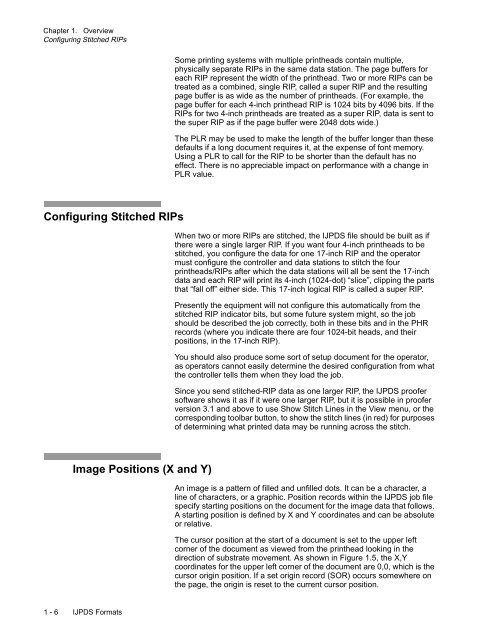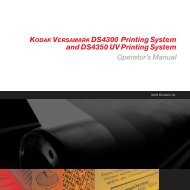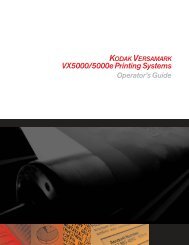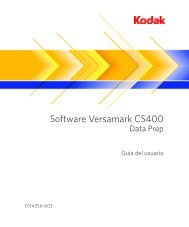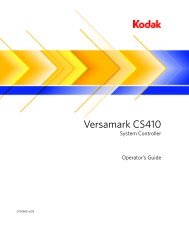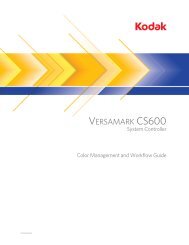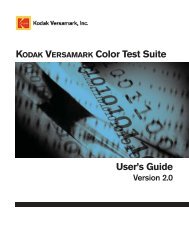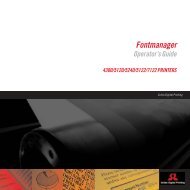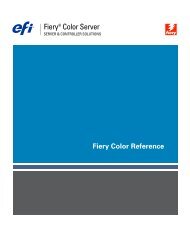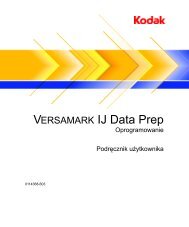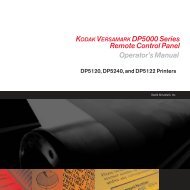Create successful ePaper yourself
Turn your PDF publications into a flip-book with our unique Google optimized e-Paper software.
Chapter 1. Overview<br />
Configuring Stitched RIPs<br />
Configuring Stitched RIPs<br />
Image Positions (X and Y)<br />
1 - 6 IJPDS Formats<br />
Some printing systems with multiple printheads contain multiple,<br />
physically separate RIPs in the same data station. The page buffers for<br />
each RIP represent the width of the printhead. Two or more RIPs can be<br />
treated as a combined, single RIP, called a super RIP and the resulting<br />
page buffer is as wide as the number of printheads. (For example, the<br />
page buffer for each 4-inch printhead RIP is 1024 bits by 4096 bits. If the<br />
RIPs for two 4-inch printheads are treated as a super RIP, data is sent to<br />
the super RIP as if the page buffer were 2048 dots wide.)<br />
The PLR may be used to make the length of the buffer longer than these<br />
defaults if a long document requires it, at the expense of font memory.<br />
Using a PLR to call for the RIP to be shorter than the default has no<br />
effect. There is no appreciable impact on performance with a change in<br />
PLR value.<br />
When two or more RIPs are stitched, the IJPDS file should be built as if<br />
there were a single larger RIP. If you want four 4-inch printheads to be<br />
stitched, you configure the data for one 17-inch RIP and the operator<br />
must configure the controller and data stations to stitch the four<br />
printheads/RIPs after which the data stations will all be sent the 17-inch<br />
data and each RIP will print its 4-inch (1024-dot) “slice”, clipping the parts<br />
that “fall off” either side. This 17-inch logical RIP is called a super RIP.<br />
Presently the equipment will not configure this automatically from the<br />
stitched RIP indicator bits, but some future system might, so the job<br />
should be described the job correctly, both in these bits and in the PHR<br />
records (where you indicate there are four 1024-bit heads, and their<br />
positions, in the 17-inch RIP).<br />
You should also produce some sort of setup document for the operator,<br />
as operators cannot easily determine the desired configuration from what<br />
the controller tells them when they load the job.<br />
Since you send stitched-RIP data as one larger RIP, the IJPDS proofer<br />
software shows it as if it were one larger RIP, but it is possible in proofer<br />
version 3.1 and above to use Show Stitch Lines in the View menu, or the<br />
corresponding toolbar button, to show the stitch lines (in red) for purposes<br />
of determining what printed data may be running across the stitch.<br />
An image is a pattern of filled and unfilled dots. It can be a character, a<br />
line of characters, or a graphic. Position records within the IJPDS job file<br />
specify starting positions on the document for the image data that follows.<br />
A starting position is defined by X and Y coordinates and can be absolute<br />
or relative.<br />
The cursor position at the start of a document is set to the upper left<br />
corner of the document as viewed from the printhead looking in the<br />
direction of substrate movement. As shown in Figure 1.5, the X,Y<br />
coordinates for the upper left corner of the document are 0,0, which is the<br />
cursor origin position. If a set origin record (SOR) occurs somewhere on<br />
the page, the origin is reset to the current cursor position.


